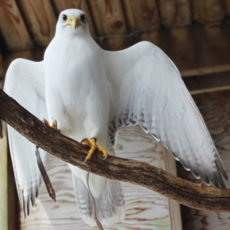Announcements

On a bright mid-August morning children spread across the lawn of our Clearpool Campus in Carmel, New York. Students had been summoned for an animal-related activity but they didn’t know what they were about to witness. Wildlife caretaker Dave Spillo arrived with a larger carrier cloaked in a towel, and as he set the carrier down, the whispers and wonders began to pick up in pace and volume.
“What’s in there?”
“Is it a fox?”
“I hope it’s a family of frogs!”
As the students continued, Dave began to explain, though his t-shirt could have been the biggest clue. “It’s a juvenile Bald eagle – a young one,” he explained wearing a patriotic profile of an eagle on his shirt. “It was found in Long Island.”
On July 11, the eagle had been discovered, lethargic and presumably dehydrated. Experts from Volunteers for Wildlife, a nonprofit wildlife hospital and education center based in Locust Valley, New York rescued and assessed the eagle. After led poisoning results came back low, the vet assessment indicated the likelihood that the juvenile eagle was having difficulty finding food and became malnourished.
Less than a week later, the young Bald eagle was transported to Green Chimneys so that it could spend time rehabilitating in our flight cage. Per standard protocol, the New York State Department of Environmental Conservation (NYSDEC) and the U.S. Fish & Wildlife Service were notified that the Bald eagle was under our care. (This is not the first time Green Chimneys has helped an injured Bald eagle by the way. Among several Bald eagles that have been cared for here is one that arrived injured in March of 2019 and eventually became a permanent resident. Read about it here.)
With help from our expert team at the Paul C. Kupchok Wildlife Center, the juvenile eagle had minimal human interaction while regaining its strength with plenty of food and exercise. Given that most Bald eagles spend a lot of time near water to hunt fish, a pool was incorporated into the flight cage so that the eagle could practice seeking and capturing food.
This particular Bald eagle was too young to have a mate but old enough that his parents were no longer feeding him. The team recognized that the juvenile Bald eagle’s greatest chance of success would mean releasing him in an optimal setting as soon as possible. After about four weeks, the eagle’s health and hunting abilities deemed him ready for a second chance at life in the wild.
And back to this story’s beginning: a beautiful summer morning on our Clearpool campus, home to a lake, wetlands, and over 350 acres of forest. Just after Dave’s introduction, the crate door was opened. For a second, nothing happened. Then, with one simple hop, the all-brown eagle, too young to have a signature white-feathered head, emerged. He then turned and showed his back to the group. He relieved himself, and then, just as quickly, the eagle gracefully flew away.
Helping animals and creating opportunities for children to connect with the natural world are at the core of Green Chimneys’ nearly 75-year history. From special education to summer camp, the children we serve are encouraged to discover, study, and show kindness towards animals and nature. Children practice skills of their own through recreational, therapeutic, and educational nature-based activities. We’re grateful to Volunteers for Wildlife for entrusting us with the care of this Bald eagle. And we’re delighted to share this opportunity with our children.
Learn more about how animals and nature enrich the Green Chimneys experience

Crowned the best for falconry in medieval times, gyrfalcons were once reserved for kings. As the largest falcon in the world, with exquisite plumage ranging from bright white to deep charcoal, gyrs are revered for their powerful skill of flight. Their long wings make hunting waterfowl from 3,000-feet-high a feasible and fantastical feat. This falcon was flown in the sport of falconry for several years.